一、 敏捷是如何诞生的
2001 年,一群软件开发人员聚集在美丽的犹他州雪鸟滑雪度假小镇讨论软件开发的新方式。他们提出了一些认为足够好,可以记下来的想法。他们当然很有野心。但他们并不清楚他们的想法能进行到哪一步。
这群软件开发人员的核心观点是:软件开发需要更加适应和快速地响应变化,他们将这种能力称之为“敏捷”。敏捷宣言的发表使这一核心概念成为了软件行业的口号。这群软件开发人员继续合作,形成了一份简洁的声明,这份声明支持强调自发协作、简单和通过追求技术卓越来满足不断变化的需求和实现目标的原则。
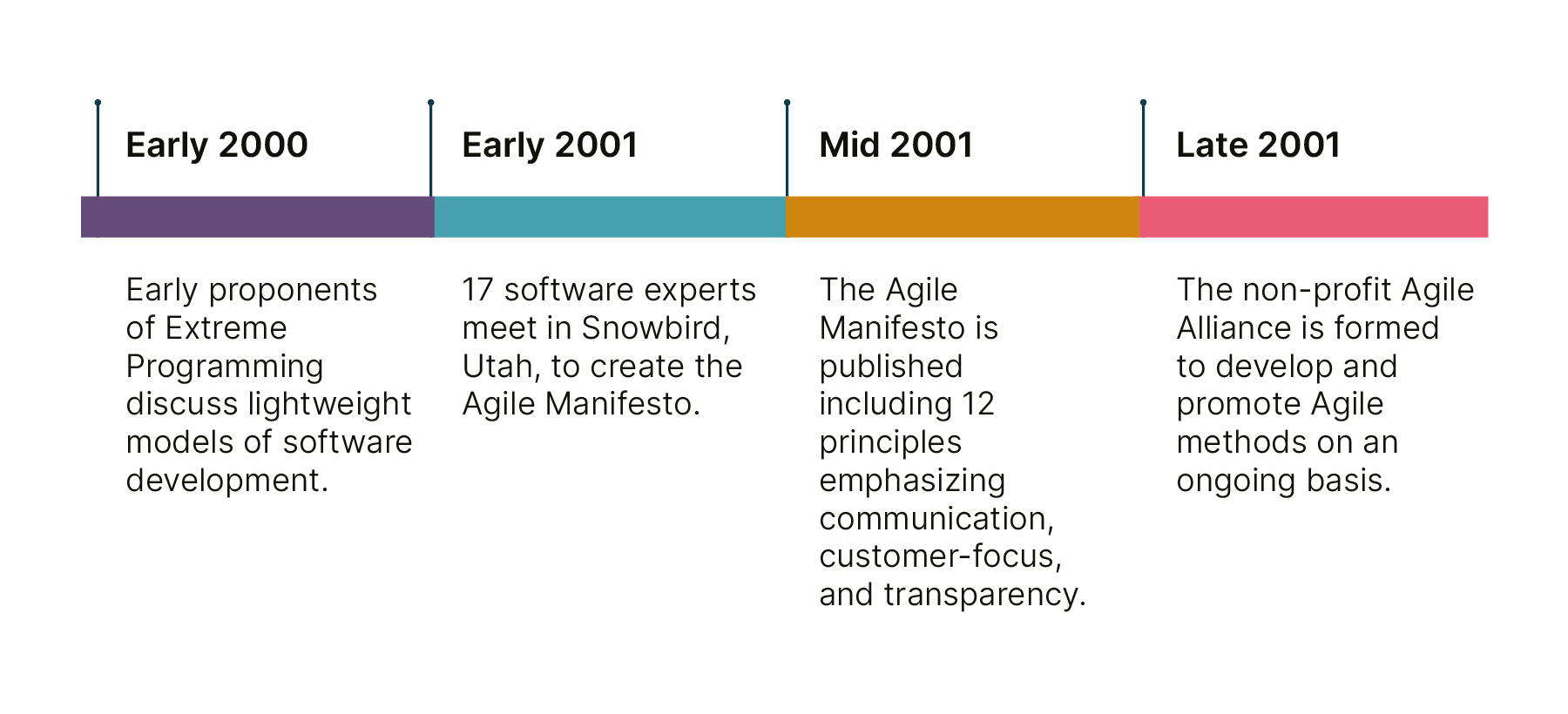
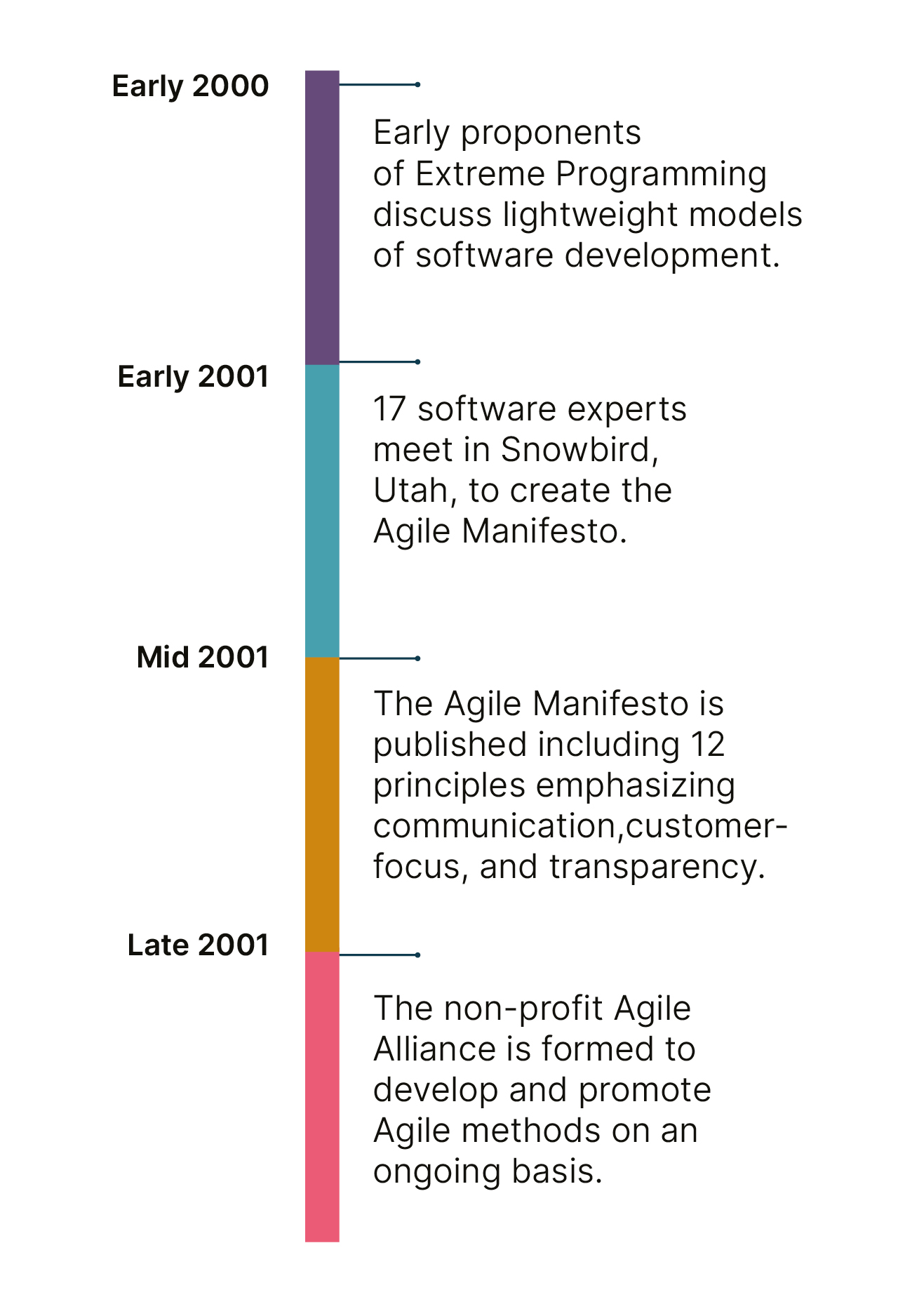
十七年后,这些原则几乎渗透到每个行业和市场,被咨询公司和商学院作为解决各种企业疾病的对策,并在书籍、管理研讨会和在线论坛中被频繁讨论。这样的结果对于最初仅仅意在激励软件行业的运动发起者来说已经很不错了,更何况他们中有些人起初甚至并不确定能否达成这个目的。
时间似乎不断证明那些对敏捷原则持否定态度的人们是错的。许多管理学热词来得快去得也快(还记得“合弄制”吗?你不是唯一一个不记得这个词的人),但敏捷的概念却长久保留了下来。Google 趋势的数据显示,2004 年之后,世界各地对“敏捷”和“敏捷认证”等词汇的兴趣稳定持续上升。不仅如此,《福布斯》、《CIO》、《Global Healthcare》和《哈佛商业评论》等出版物近期的文章均聚焦敏捷,探讨其在营销、人力资源等各个职能方面的适用性。
我没有想到【敏捷宣言】会在软件行业内被广泛接受,更不用说在软件行业之外了。一开始,人们的反应不尽相同。有些人认为这个宣言非常棒,而我们大多数软件行业的潜在客户却认为这个宣言很荒谬。
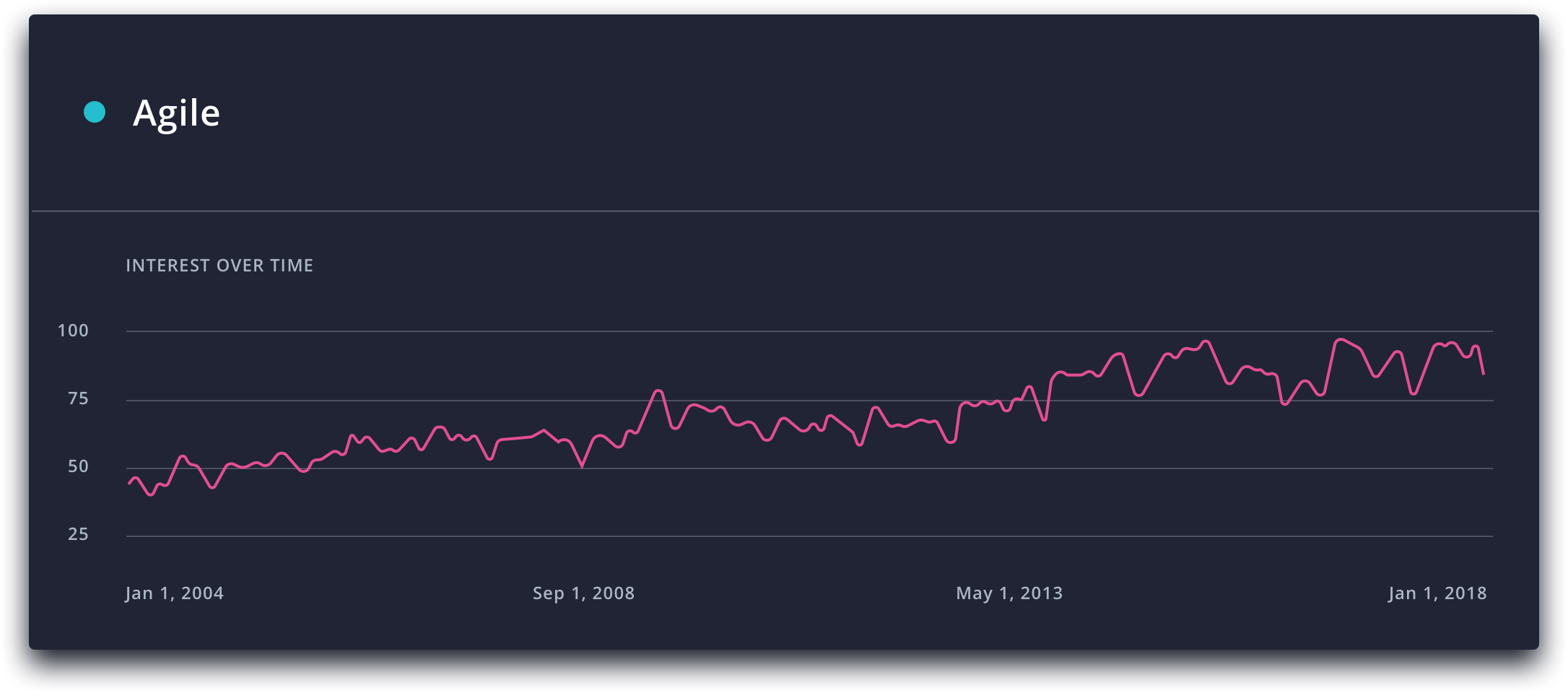
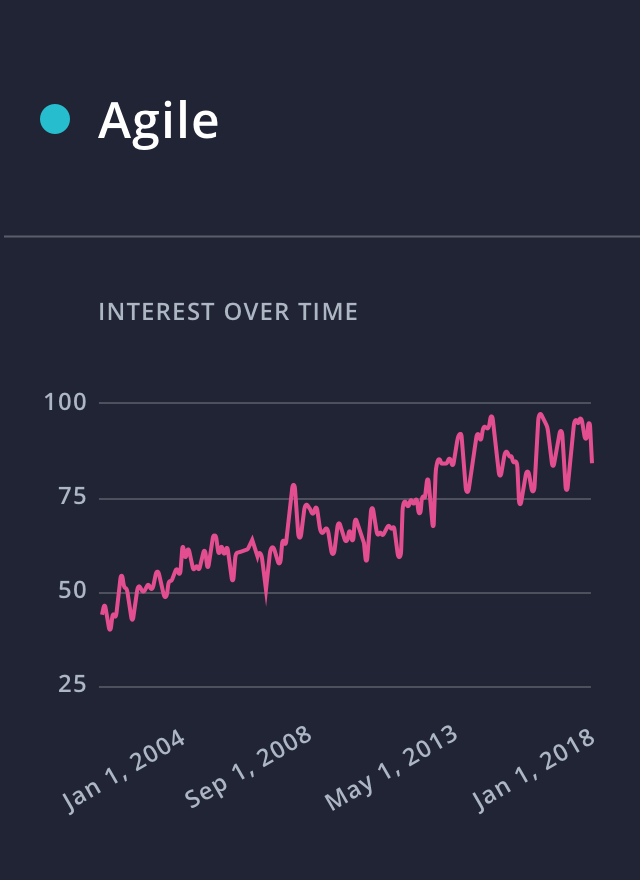
Google 趋势显示的“敏捷”搜索量
因此,按照大多数衡量标准来看,多年前起源于在犹他州的这场运动可以被认为是成功的。但是,就像成功可以使人改变一样,成功本身也会发生变化。部分最早期的支持者认为,敏捷已经偏离了其原来的意义和使命。现在已经是时候回归敏捷的初心了。这样,我们才能确保敏捷能够发挥潜力,在未来几十年内推动企业成功实现数字化转型。
二、 假敏捷的兴起
随着全面详尽的讨论不断围绕敏捷展开,Fowler 称之为“语义扩散”的现象也随之出现:术语被不断扩散,导致其初始定义被削弱并最终丢失。
虽然这个过程可能令相关概念的支持者感到不愉快,但在 Fowler 看来,如果一个想法越来越受欢迎,就会不可避免地产生这种副作用。Fowler 说:“这是成功的代价。只有当人们意识到你的想法很有价值并且愿意接受这个想法时,你才会遇到这个问题。”
与此同时,敏捷的受欢迎趋势使更多的人和组织声称渴望实现敏捷,但这些人和组织“实际上并不想了解敏捷难做的部分,只是希望有人能一挥魔杖就帮他们实现。”这些因素导致敏捷呈现出不同的形式,这些形式只是表面上看上去像敏捷,但是在很大程度上是假敏捷,这就好比时尚标签与假品牌之间的对抗。用 Fowler 的话说,假敏捷已经成为了一家“工业企业”。
Fowler 说:“【规模化敏捷框架】和认证本身以及声称买下这个培训课程,你就能变得敏捷的工具供应商都是很有问题的。”问题的核心不在于敏捷框架或本身存在缺陷的课程,而在于认定只需要买下这种课程或实施这种框架就能了事的组织。
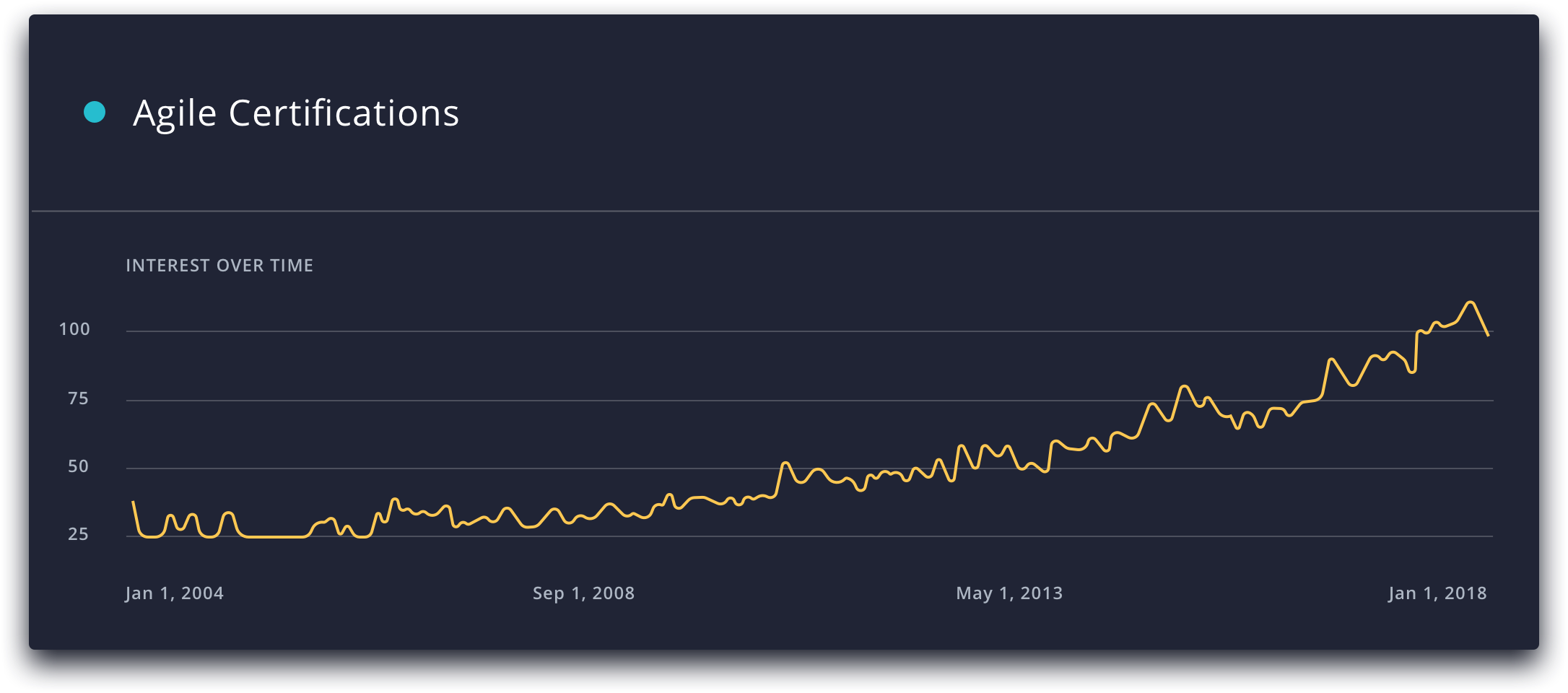
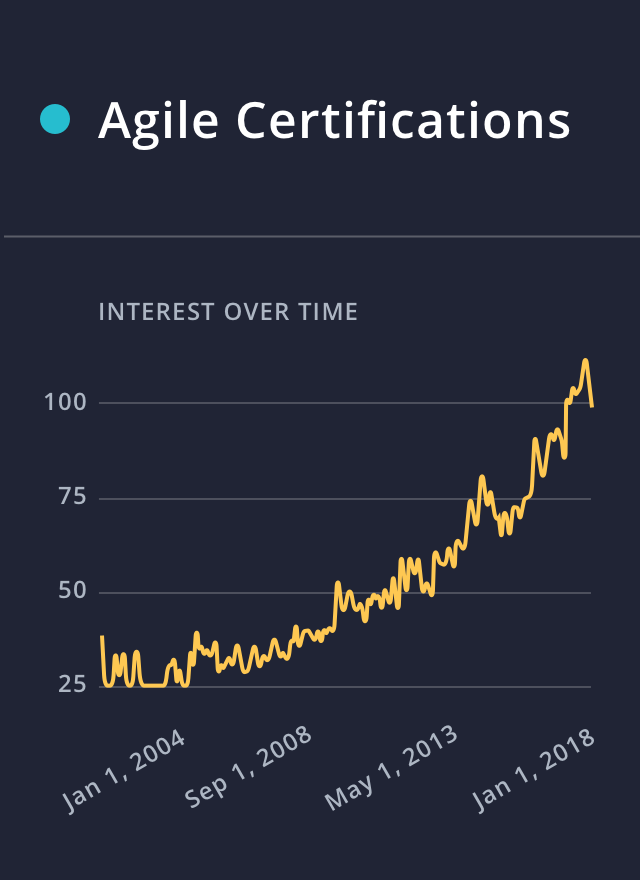
Google 趋势显示的“敏捷认证”搜索量
Fowler 说:“企业总要经历敏捷带来的困难,因为敏捷思维还包括改变工作方式。由于这种改变不是对象取向等纯粹的技术性问题,因此往往实施起来会更加困难。”
Sunil Mundra 是 Thoughtworks 首席咨询师,同时也是《企业敏捷——在变化的世界中实现敏捷》一书的作者他表示,“令人愉快的实施方式和‘只需这样做’往往是假敏捷的特点。”Mundra 说:“从这种方式入手并没有什么问题,因为总有一些流程、仪式需要执行,但是如果你只是这样做,那么因组织系统性问题而继续存在的惯性将压过你在团队层面得到的任何初步进展,最终导致你回到原来的状态。如果不理解背后的动因,你将无从获益。”
正是这种对表面变化的关注致使较多的敏捷尝试以失败告终。荷兰金融巨头荷兰国际集团高管就曾对高调的敏捷倡议的早期成果表示不满。研究表明,相当一部分的敏捷信息技术项目在一定程度上是失败的,越来越多首席信息官对这一概念持怀疑态度。
鉴于此,重新关注敏捷的最初版本(即:驱动积极的真实成果)就显得十分重要。正如 Fowler 所说,“战斗的方向已经发生了改变。十年前,我们试图说服人们敏捷实际上是值得做的事情,而现在我们需要定义敏捷的真正含义。”
三、 什么是真敏捷
那么,企业如何才知道什么是“真敏捷”?正如 Fowler 所指出的那样,真敏捷的明确特征之一是要涉及转型,而这对于企业来说往往是一个痛苦的过程。因此,许多企业都倾向于接受敏捷“行为”,即:采用一些既定的敏捷做法,而不是树立全新的敏捷“心态”。两种选择都可以产生效益,但是只有敏捷“心态”才是许多最伟大创新和最高客户满意度的来源。
组织可能由于几个常见的障碍而无法树立敏捷“心态”。一是指挥和控制思维或传统管理结构的持续存在。传统管理结构中,计划按照自上而下的方式制定,且必须不惜任何代价坚持执行。Fowler 谈道:“许多组织的基本观念认为:对事物的控制和预测程度决定了组织的能力。要抛弃这样的观念,组织需要进行巨大的转变。”
Thoughtworks 咨询副总裁,同时也是《敏捷 IT 组织设计》的作者 Sriram Narayan 表示同意,他说:“执着于可预测性和遵循既有规划方式的做法妨碍了真正的迭代开发,使软件开发未能达成目标,从而产生浪费。”
人们仍然倾向于视软件开发为流水线,认为软件需要经过不同的阶段,一点一点开发而成。
其次,名义上“扁平化”的组织中也逐渐形成了层级结构,对真敏捷所需的信息自由流通造成了负面影响。Fowler 说:“许多组织都存在权力斗争盛行的现象,权力斗争会影响人们进行真诚沟通的能力。这根本不适用于敏捷,因为敏捷需要更高程度的透明。”
最后,敏捷演变成为一般的管理学科意味着组织往往会低估支持根据客户反馈动态调整解决方案等过程所需的技术技能基础。
Fowler 解释说:“这一点是软件行业特有的,但非软件行业也有相似之处。”组织并没有对测试和开发、重构和自行决定权或所在行业的具体技术技能给予必要的关注。但这些因素确实能够促使企业从敏捷流畅度™模型的第一层次向第二层次转变。敏捷流畅度™模型提出,企业需要具备技术专业知识才能达到期望的生产力和有效执行水平。
相对小型的新组织需要解决的遗留流程和层级结构更少,因此通常更容易在重新开始时避开上述障碍。正如 Fowler 所说,“‘忘掉’知道并熟练掌握的东西比从头学习要难得多。”尽管存在种种困难,但敏捷仍有不同形式,不同程度的成功案例。
让我们来看看实践中的敏捷吧
戴姆勒:这家德国汽车巨头虽然历史悠久,但一直在积极探索新的敏捷工作方式。其中值得一提的是,戴姆勒实施了一项“群体组织”倡议,意在到 2020 年使全球 20% 的员工形成敏捷灵活的工作结构。“群体”是以团队为基础,将来自世界各地的变革者聚集在一起,融合不同的职能和资历水平,以产生有关企业转型的见解。
戴姆勒日益灵活和以员工为主导的方法为其在中国等市场的战略提供了信息,在这些市场上,创新和数字化已被证明是竞争优势的关键来源。该公司的梅赛德斯-奔驰电子商务 (MBE) 平台是中国豪车行业的首个同类平台,客户可以完全在线浏览车型、配置和订购所选择的奔驰车。该平台经过与客户和经销商合作设计,仅用七个月的时间便推出了。戴姆勒还为奔驰经销商开发了“一触式零售”移动解决方案,用于管理销售过程从商机管理到交付的方方面面。
REA 集团:REA 是世界最大房产门户网站的运营商。2011 年,这家澳大利亚公司针对其核心系统启动了重构平台项目,以提高其快速、大规模提供创新性新服务的能力。项目采用新的境外卓越中心,让境外卓越中心与 REA 的境内团队利用协同技术展开合作,按需提高能力,并为设计过程注入更多的多样性。该中心还帮助 REA 探索机器人、增强现实和数据科学等新兴技术的潜在应用。
REA 的敏捷开发方法帮助 REA 取得了几项了不起的成就,其中包括使 REA 成为少数几家能够在中国出了名的不透明网络市场蓬勃发展的跨国公司之一。“敏捷之父”、REA 首席发明人 Nigel Dalton 指出,敏捷需要辅以强大的管理和组织弹性。
Trainline:Trainline 致力于成为欧洲铁路和客车服务的一站式商店,其在线平台销售 140 多家铁路和客车公司的车票,并在 36 个国家提供实时旅行信息。与其他许多公司一样,Trainline 寻求更快向客户发布和提供新服务的方法。实现目标的关键在于简化各地 Trainline 开发团队之间的沟通,这些团队常常独立开展项目,导致管理和支持工作十分复杂。
Trainline 通过增强后端网络服务、移动优化和数据处理等功能来解决这个问题。同时建立了开发项目所有权澄清机制,制定了明确的知识转移程序。“结构化分散”方法以及在开发过程关键环节引入自动化使分布式团队交付解决方案的速度提高到平均每天发布 10 次,为 Trainline 更注重移动的客户战略计划和公司票务解决方案的推出提供了支持。
四、 敏捷如何推动数字化转型
自敏捷宣言诞生以来,技术变革和市场需求演变的步伐大幅加快,使得敏捷企业的速度和响应性特征成为不可缺少的竞争力。
与敏捷一样,数字化转型也是一种心态,而不是最终目标。数字化转型的特点包括:不断努力提高客户满意度和进入市场的速度;快速平稳地推出新的服务和解决方案的能力;以及使组织得以快速评估甚至预测自身变化或更广泛变化的影响的强大沟通渠道。
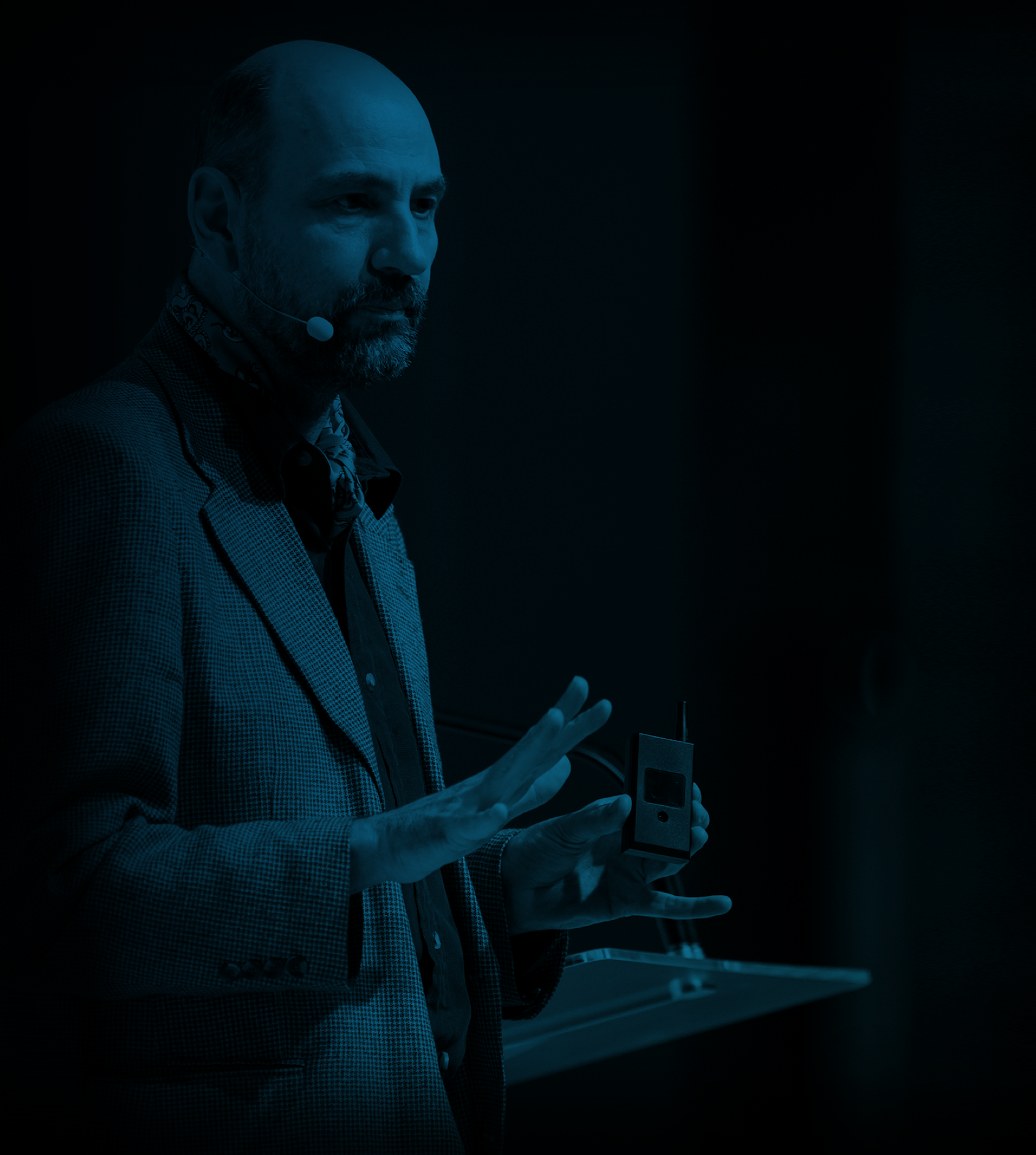
“我认为敏捷和数字化转型之间有着非常紧密的联系。数字化转型是改变工作方式的战略性行动,但是你无法预测你所做的改变将对你的工作产生怎样的影响。因此,你必须采用非常灵活的策略。同时,为了成功实现数字化转型,你必须考虑向敏捷心态转变。”
Thoughtworks 首席科学家 Martin Fowler
敏捷取决于两个关键因素,这两个因素也造就了数字化转型就绪企业。其中一个因素是跨职能团队的存在,这些团队能够有效地自我组织和高度自主地运转,但也能为相同的既定目标或宗旨而努力。正如 Mundra 所说,这意味着领导层的作用“不仅在于确保团队朝着正确的方向前进,还要消除障碍,确保团队拥有完成工作所需的一切。”
由于某种程度的层级结构是不可避免的(确实是必要的),因此企业的目标不应该是完全消除层级结构,而是利用管理层级结构的积极特征来管理层级结构。正如 Narayan 所言,大多数企业有不同的沟通、报告和决策层级结构。企业需要尽量减少前面两种层级结构,以支持数字化转型。Sriram 说:“你不能在基层员工和首席执行官之间设置 15 个报告层级。”企业应该认可最后一种层级结构。但这种层级结构应该足够分散,确保团队有权独立行动,并且(用 Sriram 的话来说)“与总体战略保持一致,并从以往的决策中学习经验。”
另一个重要的敏捷特征是没有组织障碍。Fowler 表示,企业在敏捷流畅的初期阶段倾向于注重创建有效的团队,而不是应对企业范围内更全面的变革。这可能导致组织结构内存在多个各自高效运转的高绩效团队。
如果开发团队和其他部门之间缺乏直接的沟通路线,这种结构的问题会尤其严重。这会阻碍客户反馈信息的流通,而客户反馈本应推动开发过程的后续阶段。
Fowler 说:“能够非常有效地生产软件但未必有正确联系方式的团队可能会非常快速地生产出错误的软件。如果企业在业务和软件之间设置障碍,并且认为软件就只是交付给客户的东西,那么这种生产出错误软件的现象就会经常发生。数字化转型就是要打破这种障碍,使开发必须成为一切工作的中心。”
企业在为开发团队和其他部门制定共同目标和消除企业与客户之间的互动障碍时也应该应用这种方法。
Mundra 指出:“‘良好的’敏捷是指客户完全了解交付团队的动态,交付团队响应客户的变更需求,并与客户共同决策。遇到问题时,交付团队会与客户一起寻找解决方案,即使这意味着会超时和超预算,交付团队仍然会这样做。”
评估结果,向下一层次转变
要确定企业是否成功执行了敏捷原则和进入敏捷流畅的更高阶段并不容易。但有些迹象可以表明组织走上了正轨。开创性的敏捷组织始终面临技术债务,提升技术卓越性,组织的团队也持续监测进展情况。
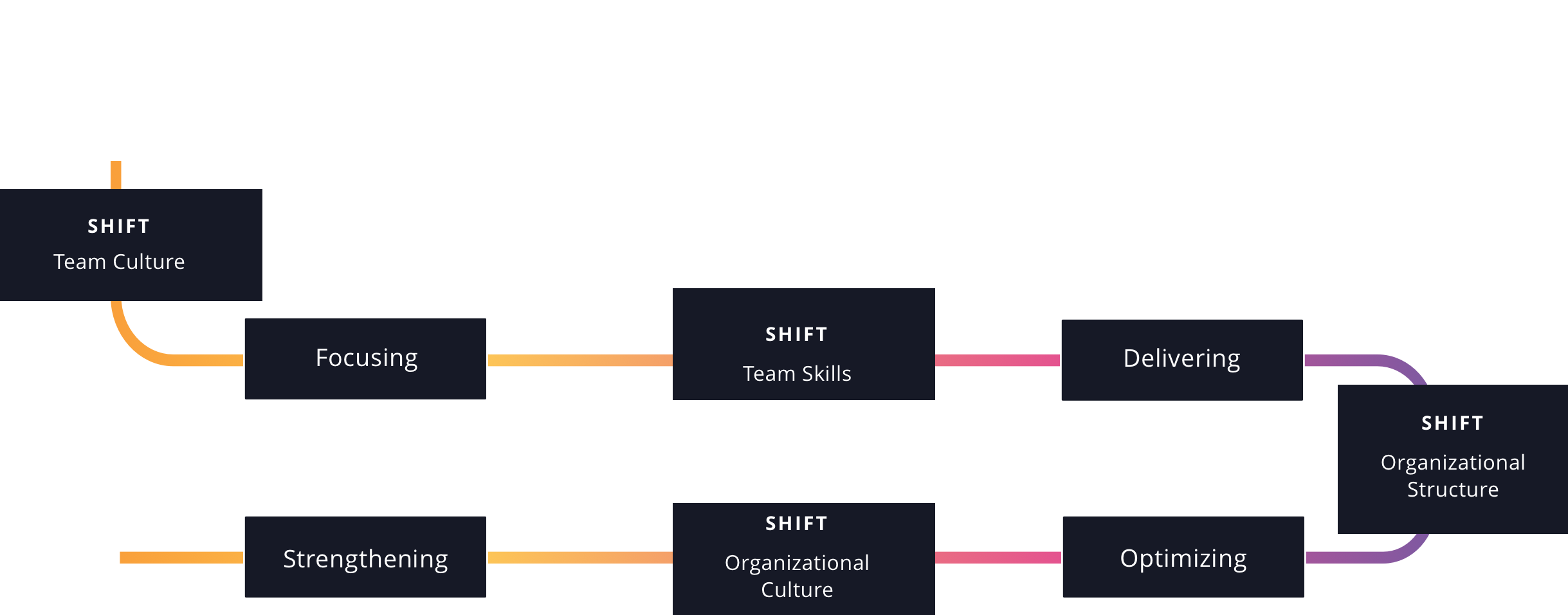

正如 Fowler 所说,企业一旦建立起必要的技术技能基础,就可以开始更高水平的敏捷流畅度了。如此一来,企业就能实现数字化转型。数字化转型以能够监测自身结果的团队等“非常酷的东西”为特征。
尽管如此,任何变革都不可避免地会面临障碍和阻力,并且需要根据变革结果进行评估、证明甚至重组。这就为企业提出了如何衡量敏捷成果的问题。专家认为,高度敏捷的标志如下:
应对反馈周期缩短的能力
Fowler 说:“(敏捷)并不容易评估。但我们关注的最主要因素之一是周期时间,也就是从提出想法到投入生产的速度。另一个方面是你能以多快的速度从正在发生事情中学习经验,并针对下一项工作提出想法。”
试错的能力和信心
进入敏捷流畅度™模型的更高层次,企业能非常迅速地看到其预期的变化,并相应采取行动,而不是对市场发展做出反应。如此一来,企业有更多的时间来测试和开发解决方案。Fowler 说:“因为你总是领先一步,所以你会获得巨大的竞争优势。这也意味着你有能力尝试六件事情,接受五件事情会失败,找出其中取得成功的一件事情,并加倍努力地推进这件事。这就是敏捷真正有前景的方面。”
高水平的客户和团队满意度
Fowler 说:“衡量组织成功的真正标准是:你正在提高客户的效率。但另一个标志在于员工方面。员工能自行决定遵循哪些流程吗?有能力的员工是否认为你是这个行业的领导者,因此希望受雇于你的组织?你是否苦于其他组织将你这里视为他们可以挖走员工,令其胜任领导角色的绝佳地点?这些问题就是你了解自己能否成功的方式。”
六、 敏捷企业的演变
企业需要不断检查这些指标,因为敏捷和转型是持续进行的过程,而不是企业能在实现之后就满足于已有成绩的终点。这些指标还表明,评估企业和定义成功的参数(其中许多源于制造时代)是由更广泛的全面调整驱动的。传统企业的重点是效率和资源利用的最大化。然而,敏捷企业优先考虑的是应对和预测变化的能力。
Narayan 先生解释说:“无论是对于客户提供的信号和反馈还是对于监管机构发出的指令,组织都必须树立响应性心态,这与以成本效率为基础的组织有非常大的不同。效率是驱使企业承接超出其能力范围的项目的重要原因,这类项目会造成积压的待办事务,从而使企业启动的项目更多,但完成的项目更少。”
Fowler 表示,从根本上来看,这些新价值观以及敏捷概念的长期存在都是基于这样的认识:“世界充满了不确定性,而你必须接受这一点。这意味着你必须向这种反馈驱动的工作方式转变,而不是不断制定计划。这种转变和对技术技能的认可是敏捷的两个真正基础。”
在收件箱中获取《视野》
为数字领导者提供及时的商业和行业洞察。
《视野》订阅为您提供我们专家的最佳播客、文章、视频和活动,以扩展我们广受欢迎的《视野》出版物。
















